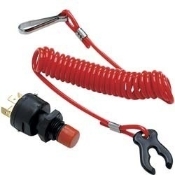General Tips and Info
Fuel Problems
Many boaters keep their fuel tanks full all the time. While this is helpful to prevent condensation, it does however start the trend of storing bad fuel. If you never run your fuel tank down to the "near empty" stage, over a period of 2-3 years you'll accumulate more and more bad fuel at the bottom of your tank. Carbon build-up, water in your gas as well as repair problems to your fuel system are preventable. Adding Sea Foam fuel additive with each filling (with fresh gas) will make a huge difference. If you're nervous about running out of fuel (trying to run your tank down to this stage) then stop by our showroom; we have portable 6-gallon fuel tanks that can give you more confidence.
Battery Storage and Maintenance
Marine batteries have special needs since they usually have only seasonal usage with minimal charging. It's a common myth that "concrete kills a battery". Actually, it's the cold temperature near a concrete structure that does the damage, not the concrete itself. Batteries should be charged before being stored for the winter and then recharged once more before installing again for seasonal use. Batteries should be stored in a warm area like on a workbench. Minimally doing these steps will give you a longer battery life.
If your battery is not a maintenance-free model you should check the fluid level at the top of the battery. It should be just over the top of each cell. If you have to add water to bring it back up to this level then use distilled water only. Chlorinated (tap) water will shorten the life of your battery. Trolling motor batteries should be checked more often.
BE CAREFUL: CHARGING BATTERIES GIVE OFF HYDROGEN. KEEP SPARKS AWAY FROM WHERE YOUR BATTERIES ARE CHARGED AND STORED. THEY SHOULD BE CONSIDERED EXTREMELY FLAMMABLE.
Resetting Your Suzuki Oil Change Reminder Light
If you've never done it before, resetting your 40HP or higher Suzuki outboard motor's oil change reminder light can frustrating. But here are the steps necessary to do it.

- Remove the kill switch clip (that's on the key lanyard at your console)
- Turn your ignition key to the ON position
- Wait until the engine monitor stops beeping
- Pull the red "kill swtich" knob three times in succession, you should hear a beep and the light should turn off
- Replace the kill switch clip again and that's it.
You should be ready to go. If you've done each of the steps and the oil change reminder light remains lit then see your dealer, there may be something else going on that needs checking.
How to tell how many hours are on your Suzuki motor
When you turn your ignition switch on without cranking the motor your tachometer will indicator an RPM rating for 2 seconds (see below diagram for RPM rating and hour equivilent) this will indicate how many hours are on the motor

Vinyl Care Instructions
Vinyl requires periodic cleaning to maintain its neat appearance and to prevent the build-up of dirt and contaminates that may permanently stain and reduce the life of the vinyl if they are not removed. The frequency of cleaning depends upon the amount of use and environmental conditions to which the vinyl is subjected. Vinyl upholstery will absorb stains and dyes from fabrics the “crock” or bleed, for example blue denim or bright prints. A vinyl protective finish, sold in stores, may help to protect the upholstery by resisting or retarding the absorption of these stains. Some household cleaners and solvents remove plasticizers from vinyl making it brittle. The procedures used for cleaning are dependant upon the end use circumstances.
For Normal Cleaning
In general, most stains can be easily cleaned using warm, soapy water and clear water rinses. Moderate scrubbing with a medium bristle brush will help loosen soiling materials from the depressions of embossed surfaces. For more stubborn stains, use the following commercially available mild detergents in accordance with the manufacturer’s instructions: Formula 409® All Purpose Cleaner*
*When opening a new container, please test the cleaner in an inconspicuous area as cleaner manufacturers may change formula without notice. We cannot be responsible when unknown changes are made by the manufacturer of the cleaner to their formulations.
Note
Detergents should never be used on a regular basis for normal cleaning. It is recommended repeated rinsing with clear water after any cleaning procedure. Full strength rubbing alcohol or mineral spirits may be tried cautiously as a last resort on very stubborn stains, if the above suggestions do not work. Indiscriminate use of any solvent, or solvent containing cleaner, can severely damage or discolor vinyls.
Bleach and Antiseptic Surface Treatment (for products specified as bleach cleanable) Bleach can be diluted ip to a 9:1 ratio (10%). Liberally apply diluted disinfectant using a sponge. Rinse with cold water several times. Wipe dry. Repeat if necessary.
Federal regulations require that guidelines on the bleach label need to be followed for antiseptic or antimicrobial purposes.
Virox 5, JohnsonDiversy Canada can be used to clean vinyls. Provisions for Normal Cleaning listed above should be followed.
Other Common Stains
Certain stains may become permanently set unless they are removed immediately. The procedure for the removal of the more severe staining agents are outlines below.
Ballpoint Pen, Permanent Marker
Ink spots will stain vinyl permanently. Immediate wiping with rubbing alcohol in a well ventilated area will remove much of the stain.
Oil Based Paint
The use of turpentine in a well ventilated area will remove any fresh paint. Dried paint must be moistened carefully with a semi-solid gel-type stripper so that the softened paint can be gently scraped away. Rinse with soap and water.
Caution
Direct contact with paint strippers will remove the print pattern from vinyl. Paint strippers are very corrosive. Take care to avoid skin contact by wearing protection.
Latex Paint
Fresh paint can be wiped off with a damp cloth. Hot, soapy water will normally remove dried latex.
Tar, Asphalt
Remove immediately, as prolonged contact will result in permanent staining. Use a cloth lightly dampened with mineral spirits and rub the stain gently, working from the outer edge of the stain towards the center in order to prevent spreading. Rinse with soap and water.
Crayon, Mustard, Ketchup
Sponge with mild soap and water. for stubborn stains that may have set, use a cloth soaked in diluted mild detergent with gentle rubbing. Any remaining stain should be washed with diluted bleach. Rinse repeatedly with clear cold water.
Chewing Gum
Scrape off as much as possible with a dull knife. Rubbing with an ice cube will assist and make it easier to remove upon scraping. The remaining gum should then be removed in a well-ventilated area using a cloth saturated with mineral spirits. Use light rubbing. Rinse thoroughly with clean water.
Lipstick, Grease, Oil, Eyeshadow, Shoe Polish
Apply a small quantity of mineral spirits with a cloth and gentle rubbing. Take care not to spread the stain by extending it beyond the original boundary. Shoe polish should be removed immediately, so permanent staining does not occur. Rinse thoroughly with water.
Candy, Ice Cream, Coffee, Tea, Fruit Stains, Liquor, Wine, Suntan Lotion, Soft Drinks
Use clear, lukewarm water and a sponge repeatedly. Any loose material should be gently scraped with a dull knife. Any soiled area remaining after drying should be gently rubbed with a cloth spotted with a mild detergent solution. Rinse thoroughly with clean water.
Bloods, Leaf Residue
Rub out any spots with a clean cloth soaked in cool water. If stubborn spots remain, use household ammonia and rinse repeatedly with a clean, wet cloth. Do not use hot water or soapsuds, as this will set the stain.
Bird Excreta, Nausea Stains
Sponge the stained area with soapy water, containing a diluted bleach, until the stain is removed. Rinse thoroughly with water.
Urine Stains
Sponge with soapy water containing a small amount of household ammonia, Rinse thoroughly with clear water.
Surface Mildew
Wash with diluted bleach, use a soft brush for stubborn growth. Rinse repeatedly with clean water.
Warning
Unspecified cleaners should not be used. Powdered abrasives, cleaners containing abrasives, steel wool, and industrial strength cleaners are not recommended for vinyls. Use of citrus-based cleaners is not recommended. Any lacquer solvent will cause immediate irreparable damage to the vinyl. Wax should never be used on any vinyl upholstery, as it will cause premature embrittlement and crocking. If flammable solvents such as alcohol, turpentine or mineral spirits are used for cleaning, then only small quantities should be employed in a well ventilated area. Exercise proper care by advising personnel in the area and keep away from any ignition source. Always wear protective gloves.


